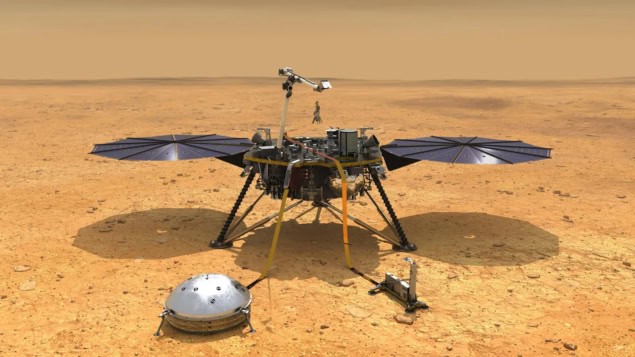
An ocean’s worth of liquid water could be trapped within the cracks of fractured igneous rocks deep within the Martian crust – according to a trio of researchers in the US. They have analysed seismic data gathered by NASA’s InSight Lander and their results could explain the fate of some of the liquid water that is believed to have existed on the Martian surface in the distant past.
Mars’ surface carries many traces of its watery past including remnants of river channels, deltas, and lake deposits. As a result, scientists are confident that lakes, rivers, and oceans of liquid water were once common on the Red Planet in the distant past.
Evidence also suggests that about 3–4 billion years ago, Mars’ atmosphere was gradually lost to space, and its surface dried up. While some water remains locked away in Martian ice caps, most of it would have either escaped into space with the rest of the atmosphere, or filtered down into porous rocks in the crust, where it could remain to this day. So far, scientists are uncertain as to how much of this water is held within the crust, and how deeply it could be sequestered.
Seismic insight
This latest research was done by Michael Manga at the University of California Berkeley along with Vashan Wright and Matthias Morzfeld at the University of California San Diego. The trio searched for buried water by analysing data collected by the InSight Lander, which probed the Martian interior in 2018–2022. To gather information about the planet’s crust, InSight’s SEIS instrument detected the seismic waves reverberate throughout the planet, originating from sources including Marsquakes and meteor impacts.
As they travel through the Martian interior, these waves change speed and direction at boundaries between different materials in the crust. This means that when measured by SEIS, seismic waves originating from the same source can be detected at different times, depending on the paths they took to reach the probe.
“The speed at which seismic waves travel through rocks of different densities depend on their composition, pore space, and what fills the pore space – either gas, water, or ice,” Manga explains. By analysing the differing arrival times of seismic waves reaching the probe from the same sources, researchers can gather useful information about the composition of the planet’s interior.
To interpret InSight’s seismic data, Manga and colleagues combined its measurements with the latest rock physics models and probabilistic analysis. They were able to identify the combinations of rock composition, water saturation, porosity, and pore shape within the Martian crust that could best explain InSight’s measurements.
Large reservoir
“We identified a large reservoir of liquid water,” Manga describes. “The observations on Mars are best explained by having cracks in the mid-crust that are filled with liquid water.”
The researchers reckon that this reservoir is sequestered between about 11.5–20 km beneath the surface and contains enough water to cover the Martian surface in a liquid ocean between 1–2 km deep. This section of the crust is believed to comprise fractured igneous rock, formed through the cooling and solidification of magma.

Mars has frost-covered mountains at its equator but no lakes at its poles
The team hopes that their results could provide fresh insights into the fate of the liquid water that once dominated Mars’ surface. “Understanding the water cycle and how much water is present is critical for understanding the evolution of Mars’ climate, surface, and interior,” Manga says.
The team’s discoveries could help identify potentially habitable environments hidden deep within the Martian crust where microbial communities could thrive today, or in the past.
“On Earth, we see life deep underground,” Manga explains. “This does not necessarily mean there is also life on Mars, but at least there are environments that could possibly be habitable.”
The research is described in PNAS.



